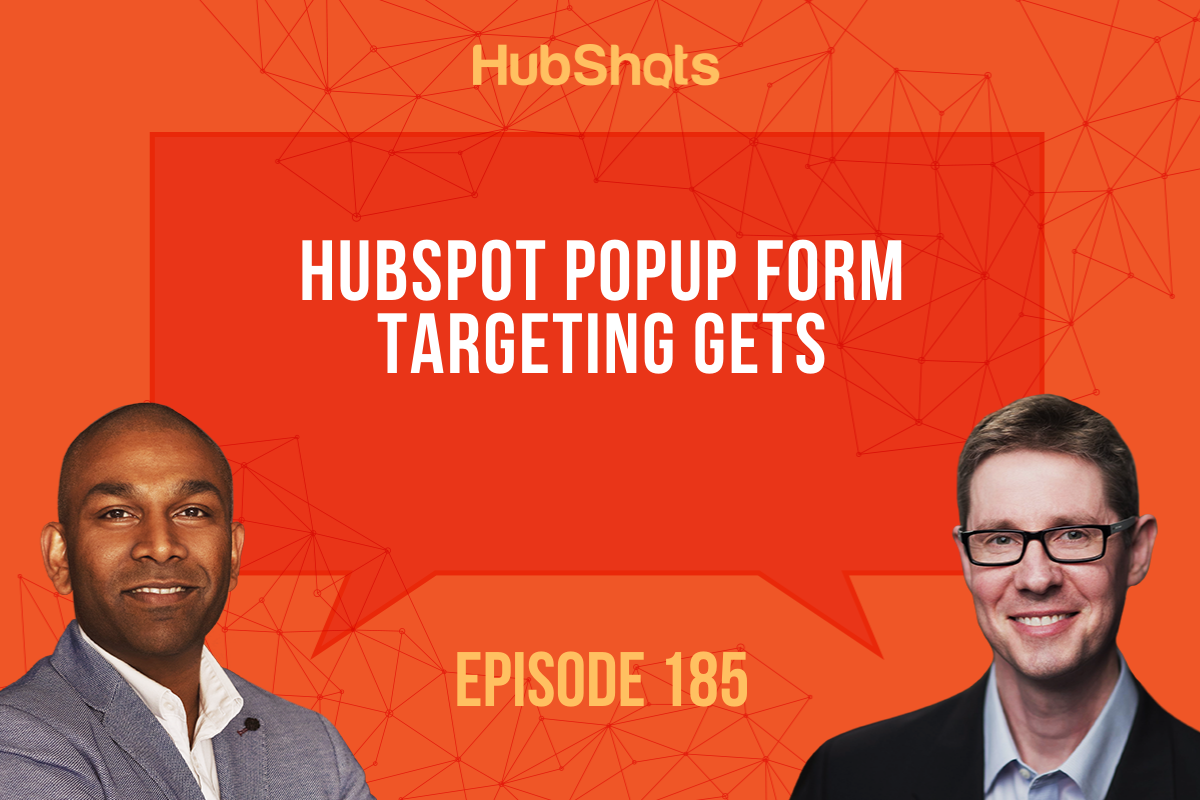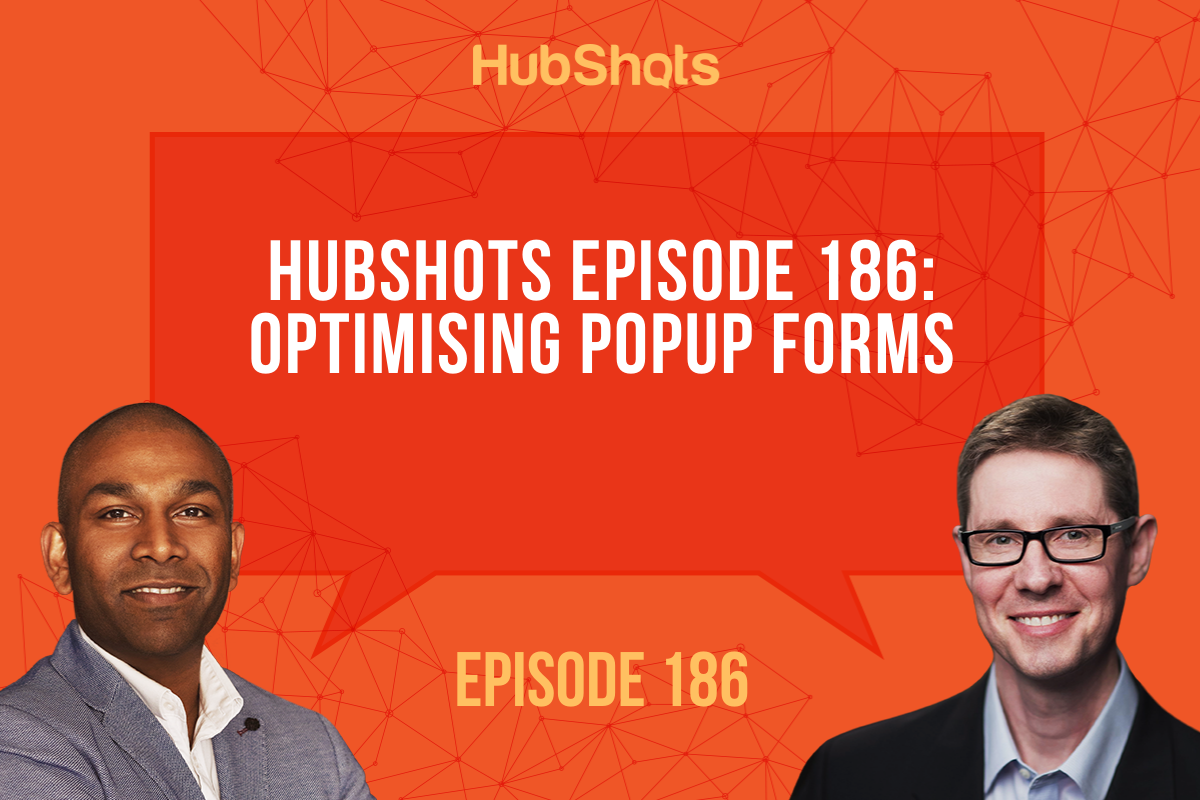
Welcome to HubShots - APAC's number 1 HubSpot focussed podcast - where we discuss HubSpot tips & tricks, new features, and strategies for growing your marketing results.
This episode we chat more about using behaviour targeting on HubSpot popup forms. Plus we ponder whether you should show ads to existing customers.
Listen to the episode here: https://soundcloud.com/hubshots/186-optimising-popup-forms/
HubShots, the podcast for marketing managers and sales professionals who use HubSpot, hosted by Ian Jacob from Search & Be Found and Craig Bailey from XEN Systems.
Subscribe to our YouTube channel here: https://www.youtube.com/channel/UCD3Uo4X-IxPJLE8ygPDQhNQ
Subscribe to our Spotify channel here: https://open.spotify.com/show/7oee8w41riN5aRNrLKT2ar
Join the Facebook group here: https://www.facebook.com/groups/hubshots/
Follow us on Twitter here: https://twitter.com/hubshots
Follow us on Instagram here: https://www.instagram.com/hubshotspodcast/
Follow us on LinkedIn here: https://www.linkedin.com/company/hubshots/
Recorded: Wednesday 11 December 2019 | Published: Friday 24 January 2020
Shot 1: Growth Thought of the Week
Have you started thinking about your marketing plans for 2020?
Welcome back (again)
To the Two Turkeys podcast - that’s a reference to episode 181.
We have stickers!
We’re recording this on 11 December 2019 but it probably won’t go live until 10 January 2020, which means that by the time you hear this you’ll be well into planning your marketing campaigns.
What have you planned? How is it different to last year?
HubSpot HealthCheck: https://www.xen.com.au/services/hubspot-healthcheck
Shot 2: HubSpot Marketing Feature of the Week
Behavioural targeting in HubSpot Popup Forms
More on behavioural targeting in Popup Forms (note: we only use slide-in forms)
Action item:
- Sort your popup forms by number of views
- Review low Submission rate forms
- Set exclusion targeting as appropriate
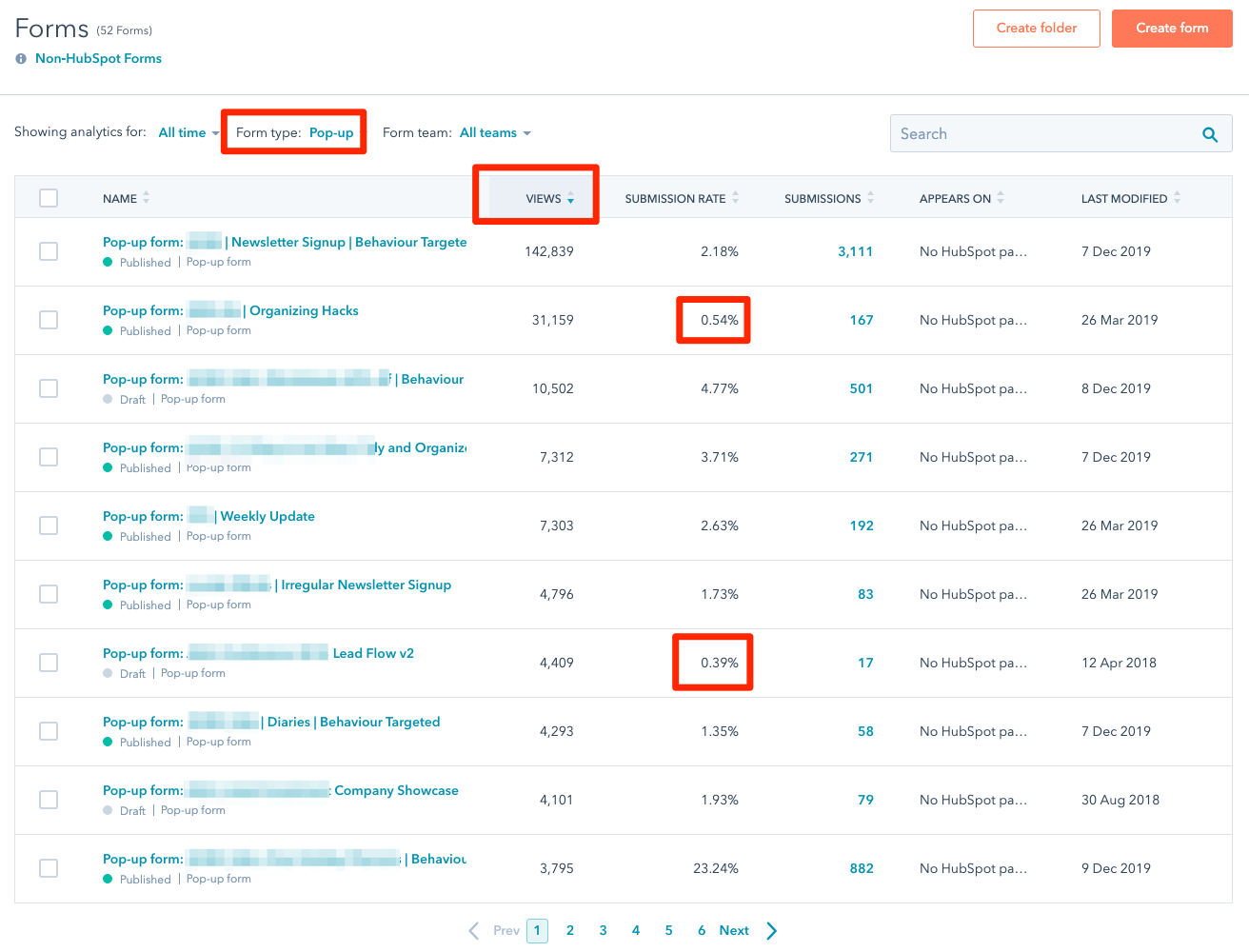
Goal is to increase the submission rate of forms
Typical opportunities:
- Newsletter and Blog signup forms that show site wide
Shot 3: Sales Tip of the Week
Own your sub-optimal processes
If you receive client feedback about issues with your processes, own it, respond quickly, improve it.
Ian shares his experience with buying a Mazda CX9.
Shot 4: HubSpot Extra of the Week
Content partitioning
Rolling out across all assets:
https://knowledge.hubspot.com/cos-general/assign-content-to-your-users-and-teams
This is coming up in more client discussions - being able to partition content and contacts between teams in companies.
Still slightly confusing to set up at first.
Take an approach of locking assets down, versus opening assets up.
Also note that it isn’t immediately obvious how to partition assets ie Assign to users
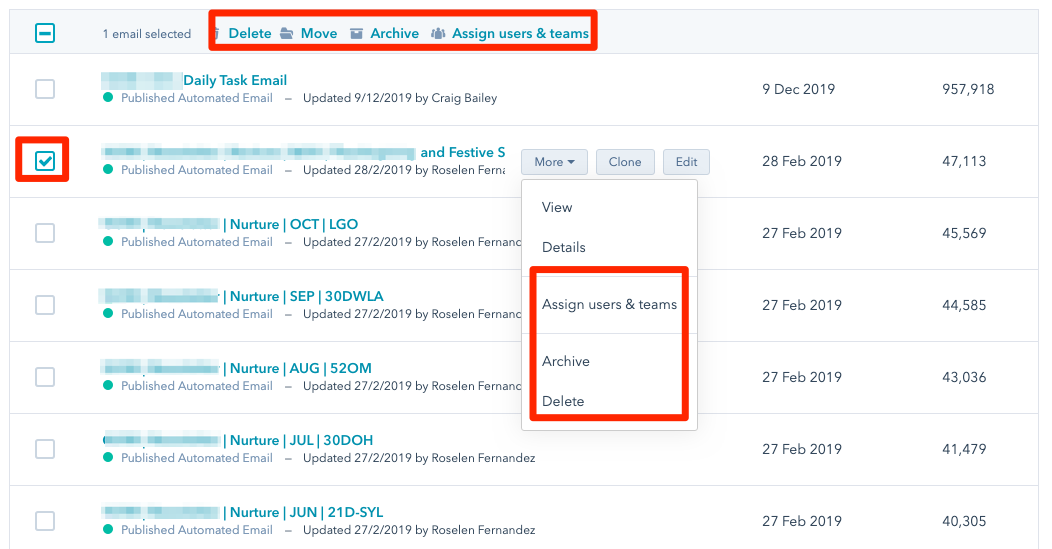
Aside: I’m not a fan of having to tick a line in order to see the actions available.
Also note that Move is not an action on the More dropdown, it is only available by ticking and seeing the actions available
Shot 5: HubSpot Gotcha of the Week
Non-HubSpot forms tracking login submissions
There’s no way to turn them off on pages like the WordPress login page
Workaround: use GTM to insert the script and set the trigger to exclude /wp- pages
Shot 6: Marketing Tip of the Week
GMB reminder
Another reminder to keep your Google My Business profiles up-to-date - it’s the only real remaining free Google asset that is still available to all businesses large and small that is easy to manage.
Some tips here:
Shot 7: Insight of the Week
Should you stop showing ads to customers?
Saw a MailChimp user on Twitter complaining that they were seeing ads for MailChimp.
They were complaining that MailChimp should know they are a customer and exclude them from being targeted.
A few comments:
- Not sure if this is intentional or not on MailChimp’s part, but I’m going to assume it is. In which case they’ve likely analysed the data and found that existing customers retain longer, use more features, or add usage, based on advertising => test and measure
- Possibly they are trying to exclude customers, but this person complaining (who is likely tech savvy) has an ad blocker that blocks tracking scripts and thus can’t be part of an exclusion audience
Takeaway for marketers:
- Make sure you have a strategy to test eg is retargeting existing customers a good ROI
- Start with an assumption (hypothesis), and test and measure
Shot 8: HubSpot Throwback of the Week
Here’s what HubSpot was announcing 12 months ago:
HubSpot renamed the Content Strategy tool to be SEO:
https://www.hubspot.com/product-updates/content-strategy-is-now-called-seo
Shot 9: Resource of the Week
Exploding Topics
A neat window into Google Trends topics
Shot 10: Quote of the Week
Your success and happiness lies in you. Resolve to keep happy, and your joy and you shall form an invincible host against difficulties.
- Helen Keller
BONUS:
“Test and Measure” - Two Turkeys
Shot 11: Bonus Links of the Week
Recorded with love by Two Turkeys.
Please rate and leave us some feedback as this helps us improve and reach more marketers.
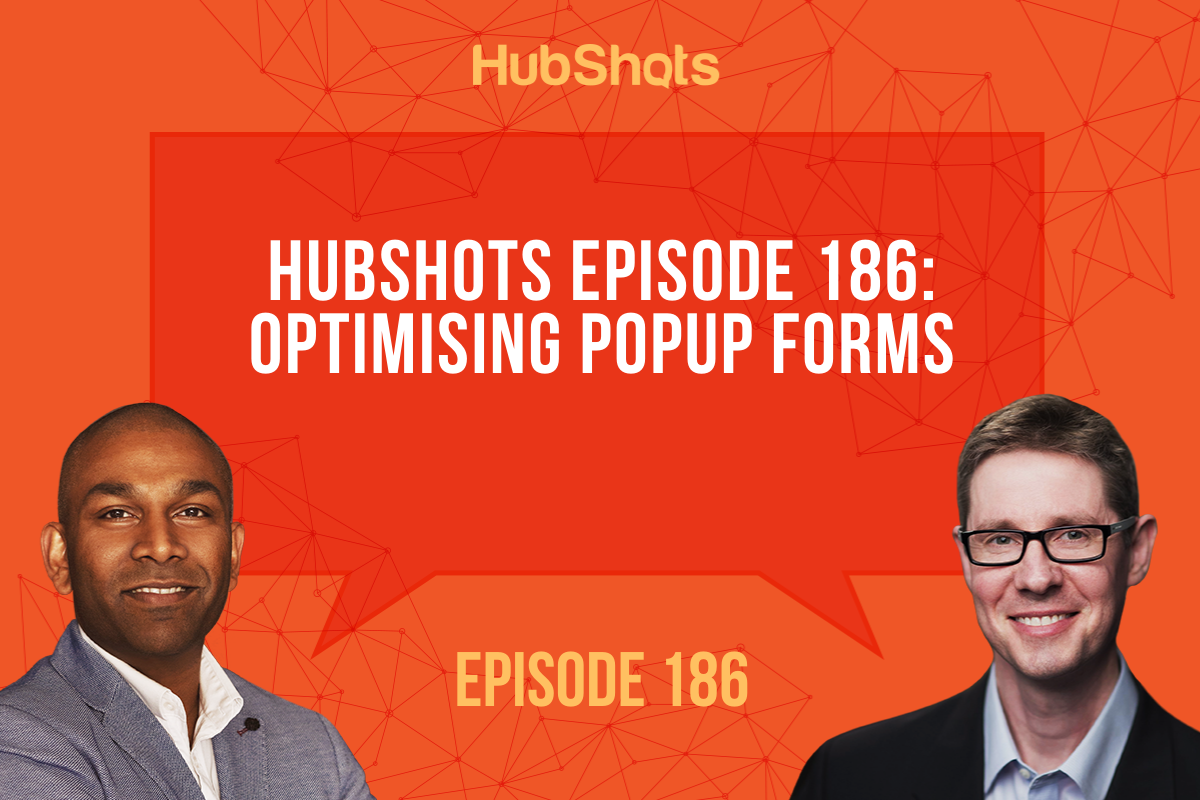
Full Transcript of the Episode
- Hi everyone, welcome to HubShots, episode 186. In this episode we chat about using behavioral targeting on HubSpot popup forms, plus we ponder whether you should show ads to existing customers. You're listening to Asia Pacific's number one HubSpot focused podcast, where we discuss HubSpot tips, tricks, strategies and features for growing your sales marketing results. My name's Ian Jacob, found with me is Craig Bailey from XEN Systems. How are ya Craig?
- Really good, and welcome to 2020. What's interesting about this is we were working out schedule for the shows. We're recording this on the 11th of December, but due to, I don't know, I'm gonna say how organized we are, but actually it's how badly organized we are, this show won't appear til probably the 10th of January hearing this. And we were realizing that this means the show you heard last week probably had us wishing you a Merry Christmas, even though it was 2020. So sorry folks, but yeah. This is our 2020 welcome back episode, also known as the Two Turkeys podcast.
- That's right. We'd thought we'd rebrand for 2020, hey Craig?
- Yes, and folks, that's a reference to episode 181 when you made an offhand comment about two turkeys, that's us, making a comment about the product. I don't know if that translates in Australia. Turkey is kind of like a, check out that turkey.
- That's right.
- It's like a bit of a fool. But I don't know if that translates.
- Not quite to our US listeners, right?
- Yeah, anyway the Two Turkeys podcast, that's us.
- So Craig, what have we got planned for 2020?
- What's interesting, it's always that start of the year is the time to think about, well what have we got planned marketing, and I am actually interested in listeners. I'd love to get some feedback from listeners what you're actually doing. I know everyone tries to be planning for the year in the previous year, so if you were really organized, you would have had your 2020 plans all--
- Done.
- All the strategy in place already, but look, let's be realistic, for most people it's not. They're coming back after a break and they're getting into it. And I think this is a good time just to reflect, think about what you're doing, and also look at how, well, not to be too blatant about it, but how you could be using HubSpot better to accelerate and automate your marketing implementation.
- Correct, and you know what's really great to staff with, is to have a HubSpot portal review, Craig.
- A bit of a HubSpot health check.
- That's right, a HubSpot health--
- Help you with that. Yeah, so check out the link in the show notes. And also an annual marketing review.
- Yes.
- This is something we do for clients.
- We've been doing that too, so that's a really good one. And you know what's really good? Having a one page marketing plan that everyone looks at. And if you just keep it front and center, I think it's a great way to realign the team and make sure that you're on track, and you know, make sure you're using campaigns within HubSpot because that'll keep you on track and you can attribute it revenue back to some marketing goals, Craig. So Craig, talking about our marketing feature of the week.
- So I'm gonna talk about behavioral targeting in popup forms again, 'cause we talked about this last--
- In the previous episode.
- And sorry listeners, again that you're hearing this in January because this feature came out, I think at the end of November actually.
- Correct. It was in the December update.
- Right. So by the time you're hearing this again, why are they talking about this new feature, behavioral targeting? Well it's because we recorded this show four weeks ago when it was new, so hopefully you're using it already, but if you haven't, here's a quick recap of what it is. It's part of the targeting on popup forms to show, to dictate where they show. So previously you could say, oh this URL, maybe some UTM parameters. Now, and it's called behavioral targeting, you can target it based on things that they've done on your site. They could've visited pages as we know, but they could be part of a list. And this is the most obvious one. Are they already part of a list? Are they a customer? Lifecycle stage, all these kinds of things, and so I want to remind listeners, that this probably one of the simplest and yet most effective things that you can get in place on your HubSpot forms on your site.
- Now Craig, what is some action items people can take away?
- All right, so here's a quick suggestion for how you prioritize this. You go to your forms listing, you just choose popup forms, you order by the number of views that those popup forms have got over the, say all time. Could be the last month but I would just say all time. And I've got a screenshot in the show notes for this. And then you pick off the ones that have the lowest submission rate. So what you're identifying is popup forms that show a lot, but yet not many people fill them out. And I'm gonna have a guess that for many people, the newsletter, and blogs subscribe forms are in this category because people have already signed up for them. So why show them again and again? Well, you don't have to anymore. You can actually go into the behavioral targeting and exclude it from showing to people who have already filled out that form. So start with those, and the whole goal is you want to improve the submission rates of your popup forms.
- Now Craig, people will often ask me, what is a good submission rate, Craig?
- Well it depends, however, I'm always looking for something more than 2%, and I think in the screenshot we've even got some over 20%. Popup forms, and I know we've got higher than that on, I probably should, you know what? I should've--
- Hyper targeted.
- I should've selectively sorted it by submission rate, 'cause I know we have some that are more, higher, but they're very specific. Typically if you've got a general site wide thing, it's not gonna have a high submission rate. But I think they'll get better now. Even site wide, because once people fill them out, it'll cut down those views and the submission rate percentage will look much better. But yeah typically 2% at least is what you're going for.
- So Craig, is one of the tips is, if someone has filled out that form, should we be adding them to a list to never show that form, popup form again?
- That's exactly right. You can create an active list based on which popup form they've filled out, so you just target that, create a specific list. And then in that form, exclude that. So it's very clear. And as we said last episode, you can then start kind of creating chains or funnels of popup forms.
- Yes.
- So since they've filled out this popup form, don't show it anymore, show the next one only to people who have filled out that previous form.
- All right Craig, sales tip of the week. Own your suboptimal process.
- Isn't suboptimal such a great word?
- It is. So if you received client feedback about issues with your process, you need to own it, respond to it quickly, and improve it.
- Now I've had an experience of this lately, but you've had an experience of it as well. So tell me about your experience where you got a suboptimal, you were part of a suboptimal process and how it was resolved?
- You know I love cars, and this was my last time I was buying a Mazda CX-9 for my wife. And so, very excitedly, you know, went in, spoke to different people, did the deal, and so I dealt with this dealership many times over. I had a great sales guy named Darren, got the car, and we were taking the car, we were going on our trip, we were going on a trip to Melbourne actually, I think for a wedding. So we were really excited.
- So just to explain. So you live in Sydney, Sydney to Melbourne is what, a 10 hour drive?
- Yeah, about eight hour--
- Actually--
- Oh no.
- Actually depending which car you're driving.
- Yeah, that's right. I think it's about eight hours, Craig, if you go straight through, 'cause the roads would become so much better now. It used to be 10 hours. So we were really excited, here we are, kind of like, probably, that was probably the first new car we've probably bought since we've been married.
- Oh and by the way, happy anniversary for you this week.
- Oh, thank you.
- Congratulations.
- And so we were really excited, anyway, going on the trip, got all the whole sat nav and everything. Anyway, the sat nav screen, all the, in cars now you've got the centralized screen, this screen keeps cutting out, right? So we've got the sat nav on, really excited, first car we've had with sat nav and all of these exciting things that show up on this really nice screen in the middle. Anyway, it keeps cutting out. I'm like, oh, this is not, this is a very suboptimal experience. Anyway, take a picture, send it to the guy, he's like okay we're cool, we'll get it sorted out. Come back, return back from Melbourne, send the car in, anyway they can't find the problem. I'm like, okay, this is not very good, because this keeps happening. So anyway I'm like, there's got to be a problem. This is happening to me all the time, like you can't tell me that just because you plug your computer, it says there's nothing wrong, it's not working. Anyway at this point I'm getting really angry, right, because they're like, there's no problem with the screen, we can't do anything, you know, we can't replicate this problem. So anyway, I had to leave the car with them. Now, and now I'm getting really angry, so now I actually now look up the general manager of the dealership and I'm like, I want my money back, I want another car essentially. You know, this is just not, this experience is getting from bad to worse. Anyway get on, I know the service manager, get on really well with him, so I said, look I think there is a problem and I don't think it's software related, it's actually probably hardware related. Anyway, this is after I'd sent the general manager an email and then he got the sales guy to respond. So he didn't respond, but I'm now trying to have a conversation with him. Gets escalated, service manager who I happen to know, who'd been there for years, like 10 years. Anyway, he goes, okay well I'm gonna take a screen out of another car and put it into your car to test it out to make sure. Anyway that happens, problem fixed. Faulty screen, right? But they would not have found that if they didn't actually take it out of one car and put it into another. Anyway, why I want to share this experience was, all through this process I've been trying to get to the man at the top to say, hey there's a problem here, and everyone's just fobbing me off, and I just, I just want to get it fixed. I like the car, I like you guys, I just want my car to work the way, what I paid for. Anyway, not once did he respond. And I was thinking to myself, is it really that hard? Are you really so far up this food chain that you can't respond to me? Like, anyway, thankfully, great service manager, great sales guy who are still there today, and every time I go in I say, I go and say hi to them. So that fixed, but you know why I wanted to highlight this is because you've had an experience, and somebody at the top of the food chain actually took the time to respond to you, which made me believe that no matter who you are, if you care about the one, you will respond.
- I think that's really important in that anecdote is, that's a real life experience where they've done a lot of work upfront to sell to you, never mind I don't know how many millions they spend on advertising etcetera every year. Get you in through the sales process, get you buy the car, and then you're really disappointed, and then it's so much pain to just get something little fixed.
- Yes.
- So the process is suboptimal, it's broken down. But yeah, so your point is though, I think that if you couldn't have contacted the right person to get it fixed, it still would've been broken. You would've been an unhappy customer. You do like cars, you talk with cars with all your friends, you're an influence to friends, you know, we all know that peer kind of recommendation. You would be bagging them out, but now you're actually a bit of a fan because luckily you got to the right person.
- Correct.
- But, it was hard.
- It was hard.
- And so tying this back to the sales tip of the week, you're really actually just highlighting that you've got to be responsive when people have feedback for you, good and bad.
- Correct.
- And respond quickly to it and fix the issue, because you've put in so much work upfront to get the sale, and then to destroy it all with actually suboptimal processes at the end. And yeah, my experience, I won't say who, but it's the CEO of a billion dollar company, who I contacted via email and they responded to me six minutes later.
- Correct.
- I have, I was so impressed. It took all, what did I say? It took all the heat out of my anger.
- Yes.
- And so that, in some ways, has just solved it. But if they just fobbed it off and didn't respond, and things like that--
- That's right. Now, it isn't resolved, right? But at least--
- It's not resolved, but I felt heard.
- You felt--
- And I know it's been actioned by the CEO of a billion dollar company. I'm just like, wow. This is impressive, this is how it should be done.
- You know what I think? It's not beyond any one of us, no matter what your position or place to actually understand and hear out people.
- And I'll just say in case that CEO's listening to the podcast, you can play it back to this date, 11th of December. Thank you if you're listening.
- All right Craig, HubSpot extra of the week, content partitioning. Now, this was something that, I don't actually, to be honest, I didn't that a lot of people were using this. It's something that was brought into Enterprise, people that manage multiple brands and want partition in between teams, etcetera. So it used to be on content and contacts, and now this is rolling across, right across the board.
- Look, it's eventually getting to everything. The reason I've put it in, in HubSpot Extra is because we are getting increasing requests for this from clients. And not necessarily huge clients. We've got a client, they're on Enterprise, but they've got a few different teams, and they just want to lock it down. They just want to be more careful I think in terms of who has access to what, contacts from pieces of content, assets, workflows, emails, etcetera. They're just getting smarter about it and putting systems in place. So, we're getting more questions about it and I think it's good to see HubSpot actually rolling this out. I mean, it's still not across everything, but it's almost there.
- Yep.
- And the comments I'm making about this I think is for marketing managers to be looking at this. We'll be actually be putting a lot more, I think thought into this for our clients, especially our Enterprise clients. It'll actually end up being something in our HubSpot health check, our service as well, making sure content partition is understood and implemented where appropriate. Here's what I'll say about content partitioning. It's still a bit difficult to understand the setup. Oh, I've got to go Users in Settings, and then set Teams, and then what do I put them as a child, team, and that, how does that work, and how does that flow up? You get your head around it eventually, but it's not that intuitive. And the other side of it is actually assigning partitions or users to teams. I think it's, and in fact, this is a general user interface comment. You know when you have to hover over things to see a More button to go, oh, that's where I can do it.
- Yep.
- Or in some cases, you actually have to tick next to an asset--
- Yes.
- Screenshot in the show notes and emails. You've actually got to tick an email if you want to move it to another folder. So some things are just not obvious. And so one of the things we've got to do in HubSpot is often just tick things to see if it shows any other option you can do. Those things aside, I think this is something that's gonna become bigger and better. The thing for people to remember is they go, oh how do I partition this content? You've got to remember, it's actually about assigning it to users. So the approach you've got to think about is, oh I've got to assign this to users as opposed to I'm partitioning this content into something else, 'cause you would naturally think, oh, I'm putting this, I'm partitioning this content. No, you're actually assigning it to users. And the final thing to remember is, you are locking down rather than opening up. 'Cause if you come from a security background, you're kind of like, everyone has access to nothing initially--
- That's right.
- And then you open it up by giving them permission.
- Yes.
- With content permissioning, to-date, everything's open to everyone and you actually have to go through locking things down. So for clients who often have to kind of say, oh okay, well we've actually got to go through everything and lock it down for you. So anyway, that's the approach, I think there'll be a lot more of that.
- That's right, and so we're not talking just to users, but users and teams, right?
- Well to teams basically.
- Exactly, so I think this is interesting because you will find that, and we've been doing this with some of our customers, is that, if you've got distributed teams, like example, you have this national sales team, and for example, businesses that they deal with are national, but have local contacts, but their company's held in a, in let's say a global space, proves a really interesting dynamic because people would say maybe have this contact that's assigned to this team, but then they go, oh no, it actually belongs to somebody in another team. Once they assign it off, they won't be able to see it, you know what I mean?
- Yeah, this is exactly right.
- So you get these scenarios. So what I wanted to highlight to people was that, yes, it's great doing all of this stuff, and you've got to really understand how it all works, and you've also got to understand how that's gonna affect usability on the user end in terms of the data and assets that have access to, and how they operate within that business, having understanding how the people in the business operate can make a massive difference.
- This is true, and this is a few other things, what you are highlighting is you've actually got to plan it out. Because you know another thing, you can't really tell what, if you go through to an asset, say your ticket and you go, oh okay, that one I'll assign it to a- oh, I wonder where it's assigned currently.
- Correct.
- It's actually not clear, 'cause you open the popup, all you've got is the option to assign it to something else.
- That's exactly right.
- And then it overrides what it previously, like I don't know what I've changed. I've got this new plan, I'll just tick that I guess. So yeah, I think, what would I call it? It's usable but it's early stage, it's not fully formed.
- All right Craig, onto HubSpot gotcha of the week.
- Just a quick one, had this from a client where they've got non-HubSpot forms being tracked. So this goes back to, remember they used to call them collected forms, 'cause you'd tick it on in Settings--
- That's right.
- Collected forms. Previously, and we covered this in a show I think a year or two ago. Previously, you could turn off tracking on specific collected forms.
- Yes correct.
- Around the time they changed the name to non-HubSpot forms, they took that away. So the question that I got from our client was, oh, can I turn off tracking of one particular form?
- Yes.
- And in their case, they've got Wordpress and the login page.
- Which always triggers.
- Is a form and it's getting collected as a non-HubSpot form. They go, oh I just want to turn those off, we don't want them coming as contacts in--
- Yes.
- And I'm like, well, unfortunately- well they're using the HubSpot plugin on Wordpress.
- Correct.
- So it just defaults--
- That's right.
- The only workaround is, well, instead of having the Wordpress plugin, use Google Tag Manager, insert it and on the trigger, do an exclusion on certain pages, by which time their eyes were glazing over, and you know, that wasn't an option. So look, it's a bit of a gotcha. If it really is problematic for you, chat to us and we'll talk to you about Google Tag Manager being used.
- All right Craig, onto market of the week. And this is to do with Google My Business. And, the really, the importance of it. So even in 2020, I think this is gonna be really, really important.
- Look, the window on this is closing out, folks. Google My Business is still free. I can't believe it. They're gonna charge for it surely soon. But it's the only free thing left on Google, that small and big businesses are kind of--
- Exactly.
- Equally able to do. If you're a small business trying to rank well for terms, good luck, versus big brands. And if you don't have the budget to advertise, you know, see ya later. But Google My Business, your listing is there, you can be a small business and still feature prominently in Google My Business through a few quick optimizations. So we've got a link to an article which just gives some tips. How many times have we mentioned this on the show? Folks, just get your Google My Business profiles up to date and keep them updated. At some point, this opportunity is gonna close down.
- Right. So I wanted to highlight some of the things. This is a really good article. It says how to level up from Google My Business apprentice to being a Google My Business master. One of the things it said, is just really being on top of it. Like, looking at it, updating it daily. I was like, oh, okay. And you know what? That's the reality. If you're in a business, and especially one that's got a physical location, it's a really good way to get in front of people, from putting a post, putting up specials, making sure your times updated as you go into the new year and there are holidays coming up. You know, what are those holidays, how does it affect you? Because there's nothing worse, and this has happened to me, looking into, like you're on a weekend or a public holiday, you're looking to go somewhere to have a coffee or to have, you know, take the family out for something, and then it says, oh yeah, it's open. You get there and it's closed, you're like, you're really peeved, you know what I mean? So, just think about that. If you're closed, mark yourself as closed. And make that's happen, and make sure it's updated across not just your local listing, but even on your website. Like have a note on there. You could even implement a popup form saying that you're actually closed on this particular day, and you'll be back on this other day etcetera. So there are things that you can do really easily to make sure people don't get peeved off.
- Yeah, that's good, and that's for the daily updates. I don't know if we do things daily, but we definitely do it weekly for clients. In marketing, we often talk about five dollar tasks, $50 tasks, and $500 tasks. Now, as an agency senior person, I should be doing $500 tasks.
- Yes.
- So I shouldn't be doing small five dollar tasks. Updating Google My Business is a five dollar task. You know why? You can just, it's a simple process. You get the most junior person on your team to do it. And why am I mentioning five dollar tasks? Because with a five dollar task, the ROI on this is incredible. We do, I think we do this for just about every client. We just, it's standard, tick a box, every client, we update their Google My Business profiles for them weekly, right? Because the impact is so, the return on that--
- That's right, exactly.
- Five dollar task investment is so strong. So folks, please. Just--
- Even for your SEO, Craig.
- Get a process.
- All right, I think we'll do another episode just about that later on this.
- We could, yeah you're right. We could do a whole Google My Business episode. You know what? I'd love the HubSpot Social tool to include support for Google My Business posting.
- Yes.
- It doesn't. Some of the other social tools do.
- That's right. All right Craig, onto our Insight of the Week. Should you stop showing ads to customers?
- I was on Twitter the other day and saw someone complaining. They're Mailchimp power user and they were complaining that they were getting advertising from Mailchimp. Kind of complaining about. Oh, surely Mailchimp knows I'm a customer. I have eight different accounts with them. Why are they showing me ads? Right? As if, how stupid Mailchimp are. And I thought about, I was thinking, well actually, there could be a lesson here. Maybe they're totally, Mailchimp's just blasts it and forget they're not doing it right. And so the first comment is to marketing managers listening to this, just be mindful of this kind of stuff. Should you be identifying customers and excluding them from mail 'cause- Not from mail, from marketing and from advertising, because it could be wasteful, and it could be pissing them off as in this case. Then I was thinking further, I was like well, two things. One is, I think Mailchimp's pretty smart. I actually wonder if they've done a test and measure. They know who customers are, they've probably segmented them out, and they've perhaps looked at, if we advertise to customers, does that improve retention or make them use more features, or they create more accounts? They might've, they might not.
- You're quite right.
- But they might. So the second take away is, well, test and measure folks, because, just 'cause they're a customer, it might actually be worth advertising to them. Quite often brand reinforcement and there's a kind of brand affinity and loyalty. Oh, they advertise, and perhaps you're actually showing new features.
- Exactly.
- If they're advertising which you might not have realized. And then the other thing I was thinking of, this person was pretty savvy. So they know about tracking and getting targeted and all that.
- Yes.
- And I'm like, I bet that person's like me and has an ad blocker and blocks half the tracking pixels. So even if they wanted to--
- That's right!
- Mailchimp couldn't exclude them. So it's like, I don't know the, what the, I don't know what the answer is in this case. Were just a few thoughts there around, I think the takeaway is, have a strategy or an assumption test and measure.
- I couldn't agree more, Craig, and I was saying, I've been doing something similar for another customer of ours recently, where they have specials that they sell to dealers and to end users, and because a lot of the people that they sell to a, in government or bigger businesses etcetera, email deliverability isn't that great when it comes to email marketing. So we kind of use this strategy of doing the email marketing, but also targeting people on Facebook and on Google with that same deal there is in special, and they should check it out. And being customers, 'cause sometimes they might not actually see it in their emails. So that was the strategy behind that.
- That's a really good strategy. Sort of another one is, especially in the email space, like Mailchimp, and there's so many providers of that space, they're probably getting targeted by competitors--
- Exactly.
- So you may as well keep your brand in front of them as well, so people churn between platforms pretty quick. They're pretty quick to jump ship, so maybe just keeping your brand in front of them, even if they are a customer, at least retains them.
- All right Craig, Throwback of the Week.
- I think it's fun to look back 12 months ago and see what HubSpot was promoting as new. And you know what they were promoting as new 12 months ago?
- The content strategy tool.
- What is this content strategy tool yet you talk of? It's now called the SEO tool.
- That's right, and you know what? I actually wonder what the usage of that tool is to be honest, 12 months on. Because I know for a fact, I've been working with customers to try and implement that, and it's been a hard work.
- You know what? It is a good tool. We've been using it with a client recently. It's actually quite good, but it's not compelling. And it's hard to set up, and we had to explain it to them, and then we were showing them. They're like, what's all this branching, and what's going on? And how do I report on it? And of course we integrated Google Search Console, the pulling down, they're like, oh, it's not showing. Oh okay, we've got to put in specific columns. They're like, there's something, well not intuitive about it, the SEO tool, and it needs training. It needs--
- It does, it definitely needs training and it does need people to guide you through it. I think, yeah you're right. It does need guidance. People need to be on the same page. Now Craig, the Read of the Week is, something to do with exploding topics.
- I think Brian Dean from Backlinko might've created a site.
- I know, I just saw this. I was like, this is really nicely done.
- Yeah, and keep in mind folks, this is, we're recording this in December. It just came out a week or two ago. It's probably old news by the time you're listening to this. But it's just a, what would we call it? A window into Google Trends, where he's just pulled out some, well he calls them exploding topics. Google Trends, trends that are taking off, and wanted to see how they fit. Worth a view.
- Definitely worth a look. All right Craig, the Quote of the Week?
- You've got a good one here.
- Your success and happiness lies in you. Resolve to keep happy, and your joy, and you shall form an invincible host against difficulties. And that's from Helen Keller. Now Craig, you've got a bonus as well.
- The quote is, test and measure. And that's from Two Turkeys.
- Well users, I hope you've had a, I hope you've had a good holiday and you've enjoyed listening to HubShots. We'd love you to leave us a review. I'd love you, if you could share it with somebody on your team, that would be fantastic. And, by all means, please you know, fill out a contact form, message us via Instagram or LinkedIn, however, however you want to get in touch with us, we love hearing from you guys. And we hope, here's to a great 2020. Until later Craig.
- Catch you later Ian.
- Thank you for listening to this episode of HubShots. For show notes, resources, HubSpot news, including practical strategies you can implement, visit us at HubShots.com
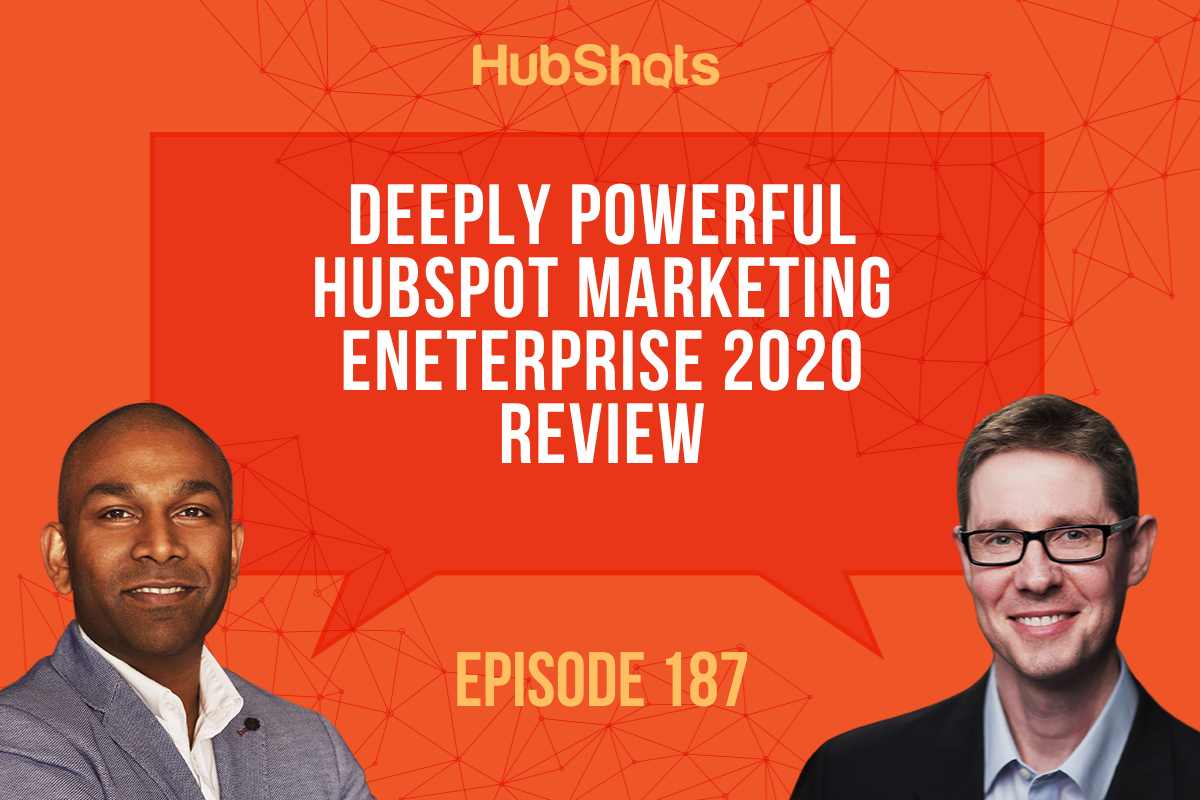
Episode 187: Deeply Powerful HubSpot Marketing Enterprise 2020 Review
Welcome to HubShots - APAC's number 1 HubSpot focussed podcast - where we discuss HubSpot tips & tricks, new features, and strategies for growing...
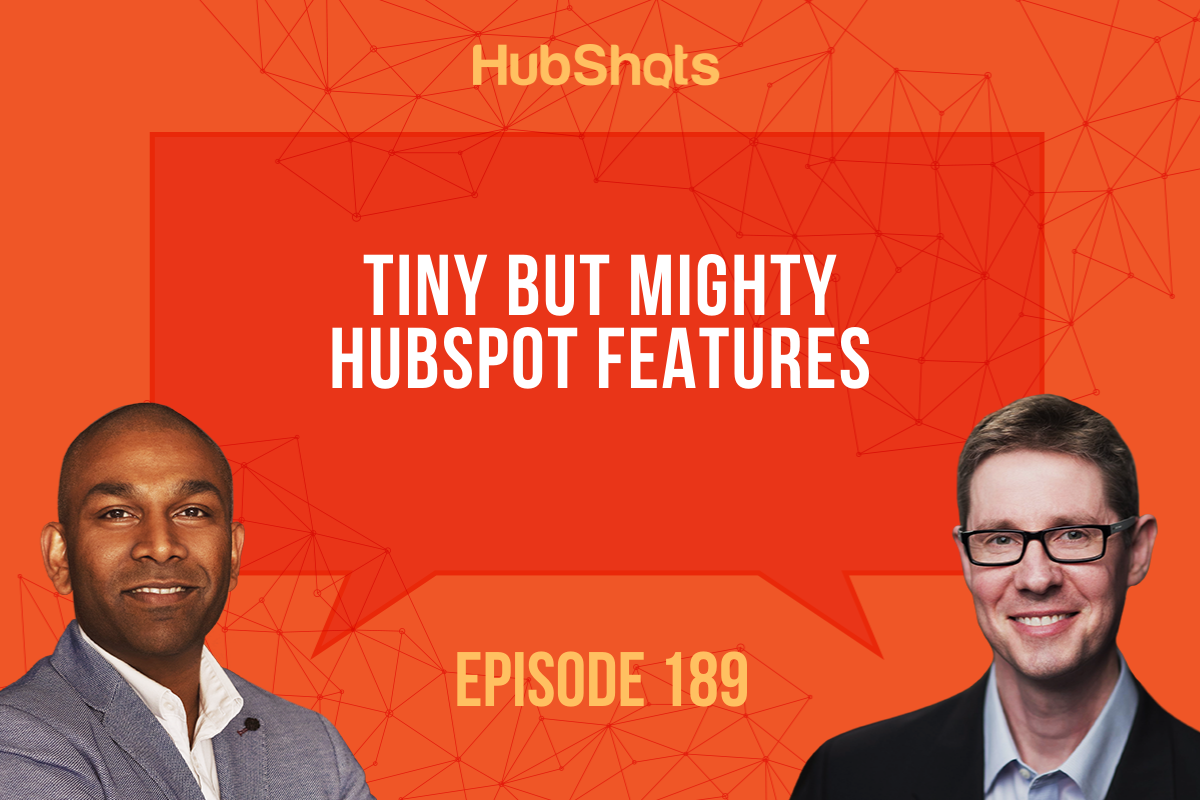
Episode 189: Tiny but mighty HubSpot features
Welcome to HubShots - APAC's number 1 HubSpot focussed podcast - where we discuss HubSpot tips & tricks, new features, and strategies for growing...



